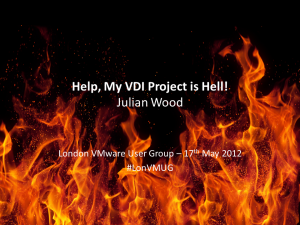Help, My VDI Project is Hell! – a London VMUG presentation
 Today I have the pleasure of talking at the London VMware User Group.
Today I have the pleasure of talking at the London VMware User Group.
My presentation is called Help, My VDI Project is Hell!
There are many complexities with VDI projects causing many to fail at the planning stage, at the POC or testing stage or even worse during the implementation phase.
I go through some of the Magic Fixes that VDI is meant to solve and what the reality often turns out to be with all this new technology you need to consider.
Looking at some research stats, many companies are doing VDI for the wrong reasons with many thinking they should do VDI to save costs and then realising this often isn’t the case.
VDI is great for many use cases, remote connectivity, security, quicker provisioning, containing your VM info, maybe availability, maybe easier management but can be also terrible in many circumstances with performance, user experience, cost, peripherals, licensing, flexibility, support and general complexity issues.
I then go through the 3 things you need to work out, your strategy, your apps and your users.
Your strategy is what you are trying to achieve from a business perspective. If your business strategy is to use VDI you are already heading down the wrong path. VDI is a technology you can use to realise some of your business strategy but it should not be your business strategy in itself. Your tech strategy is not just about VDI or desktops or streaming or server based computing or laptops or tablets. It’s all of them. Stop thinking about it from just an infrastructure layer, don’t get fixated on the I in VDI. What you are actually trying to do is develop an application delivery strategy. Desktops are useless without the applications so move your focus away from the desktop element and rather towards applications. Have a holistic view of everything that makes up your desktop / application technology environment and factor that into your planning.
You then need to map out your applications and find out how they can be delivered and what constraints there are.
You then need to map out your users and group them based on locations and applications and get an understanding of who needs what.
Once you have this information you can start to bring it together. Your strategy, your users and your apps provide the Why, Who and What of your plan.
You can then start to decide which application delivery mechanism is suitable for different groups, locally installed applications may be fine or stream some of them or use XenApp or VDI. Don’t keep thinking in silos. There’s no prize for having to have 100% of your company on VDI. Businesses who use the right technology where it makes sense are the successful ones. Make sure you have a valid reason for using VDI, when you use it in the right place it will be awesome. Yes, it will cost more but that’s quite OK if you are going to be able to do more and now achieve your business goals.
VDI is also not server virtualisation. Virtualising servers saved money and was awesome so surely it must be great for VDI is just plain wrong, VDI is much more complex and needs far more to get it right.
I then look at some things you need to get right in your build if you decide to use VDI and go on to talk about being realistic and honest with your cost models and offer some tips on things to watch out for and how to make it work.
Then some information on VMware’s future with its End User Computing.
Here’s a link to the presentation:



I really enjoyed this talk yesterday and the presentation powerpoint has lots of detail. I have circulated at work to get people to think beyond the technical issues of VDI.
@Peter Polkinghorne
Thanks, Peter, good to see you at the VMUG. Glad it was useful and hopefully helps with your project.